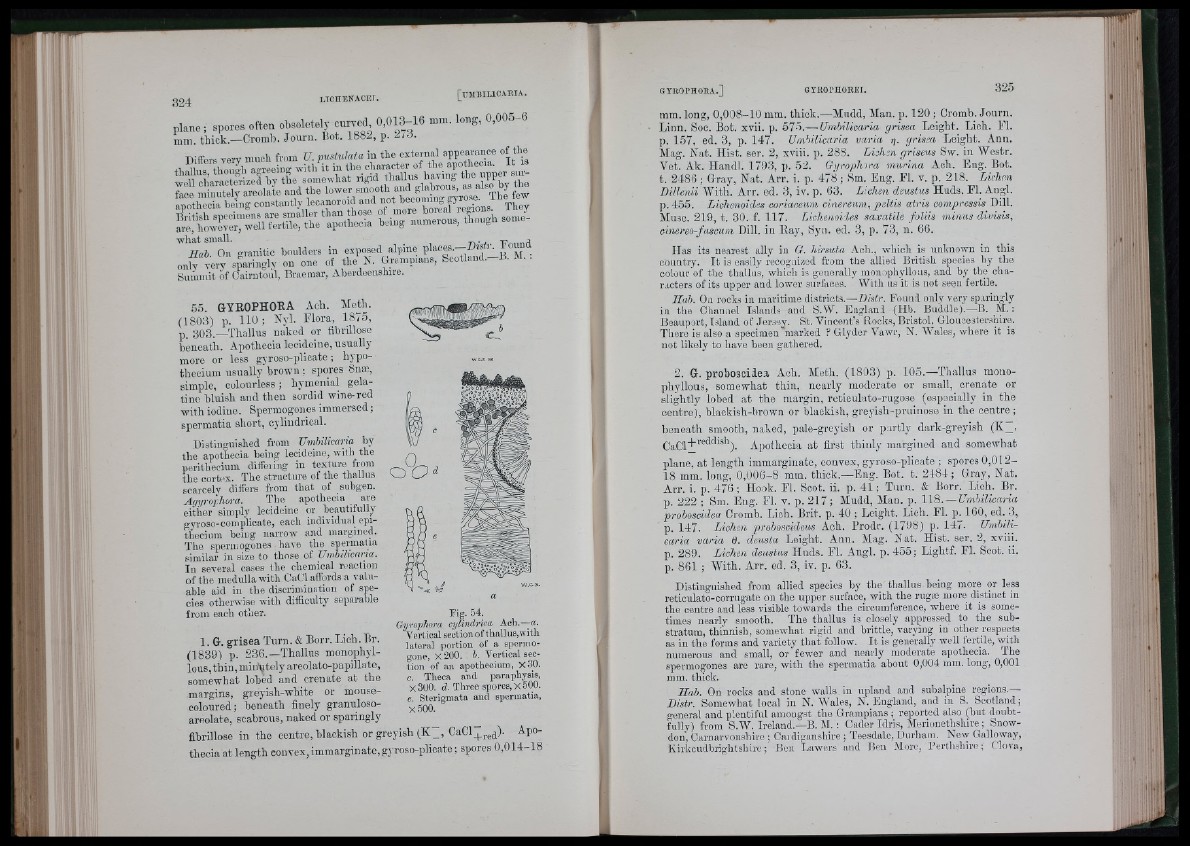
piano ; spores often ohsoletely- curved 0 ,0 1 3 -1 6 mm. long, 0 ,0 0 5 -6
mni. th ick .—Cromh. Jo u rn . Bot. 1882, p. 2 /3 .
Tiiffcrs verv much from U. pustulata in the external appearance of the
■what small. -PnnTirl
Hab. On granitic boulders in e.xposed alpine .
only very sparingly on one of the ^ . Gramp.aos, Sco tlan d .-B, M. .
Siuhmit of Cairntoul, Braemar, Aberdeensliire.
55. GYROPHOEA Aoh. Aletli.
(1803) p. 1 1 0 ; Nyl. Flora, 1875,
p. 3 03.—Thallus naked or fibrillose
beneath. Apotheoia lecideine, u sually
more or less gyroso-plioate; hypothecium
usually brown ; spores 8nie,
simple, colourless ; hymenial gelatine
bluish and th en sordid wine-rod
with iodine. Spermogones immersed;
spermatia short, cylindrioal.
Distinguished from Umbilicaria by
the apothecia being lecideine, w-iUi the
perithecium diffeiiiig in texture from
the cortex. The structure of the thallus
scarcely diftei-s from that of subgen.
Ayi/rophora. The apothecia are
either simply lecideine or beautifully
gvroso-coniplicate, each individual epi-
thecium being narrow and margined.
The spermogones have the spermatia
similar in size to those of Umbilicaria.
In several cases the chemical reaction
o fth e medulla with CaCT affords a valuable
aid in the discrimination of species
otherwise with difficulty separable
from each other.
1. G. g ris e a Turn. & Borr. Lioh. Br.
(1839) p. 2 3 6 .—Thallus monophyllous,
th in , miii\itely areolato-papillate,
Fig. f)4.
Gyrophora c y lin d r ic a A ch .— a
V e rtic a l section o f tb a llu s ,w ill
la te r a l p o rtio n o f a sp erin o
gone, X 200. V e rtic a l sec
tio n o f an a p o th e c ium , X 3 0
c. T h e c a a n d p a ra p h y s is
X3 0 0 , (J. T h re e spores, X 600.
e. S te rigm a ta anct sp e rm a tia ,
X5 0 0 .
somewhat lobed and crenate at the
margins, greyish-white or mouse-
coloured; beneath finely granuloso-
areolate, scabrous, naked or sparingly
fibrinose in the centre, blackish or greyish ( K / , CaC7^.g^). Apotheoia
at length convex, immarginate, gyro.so-plioate ; spores 0 ,0 1 4 -1 8
mm. long, 0 ,0 0 8 -1 0 mra. thiok.—Mudd, Man. p. 120 ; Cromb. Journ.
Liun. Soo. Bot. xvii. p. 575.— Umbilicaria grisea Leight. Lich. FL
p. 157, ed. 3, p. 147. Umbilicaria varia r¡. grissa Leight. Ann.
Mag. Nat. Hist. ser. 2, xviii. p. 288. Lichen griseus Sw. in Wostr.
Vet. Ak. Handl. 1793, p. 52. Oi/rophva murina Aoh. Eng. Bot.
t. 2488 ; Gray, Nat. Arr. i. p. 478 ; Sm. Eng, El. v. p. 218. Lichen
Dillenii With. Arr. ed. 3, iv. p. 63. Lichen deastus Huds. Fl. Angl.
p. 455. Lichenoides coriaoeum cinereum, peltis atris eotnpressis Dill.
AIuso. 219, t. 30. f. 117. Lichenoi-les saxatile fo liis minus divisis,
einereo-fuscum Dill, in Eay, Syu. ed. 3, p. 73, n. 66.
lia s its nearest ally in G. hirsuta Ach., which is unknown in this
country. I t is easily recognized from the allied British species by the
colour of the thallus, which is geuerallj' monophyUous, and by the cha-
r.icters of its upper and lower surfaces. With us it is not seeu fertile.
Hah. Ou rocks in maritime districts.—Bistr. Found only very sparingly
iu the Channel Islauds and S.W. Euglanl (lib . Buddie).—B. M. :
Beauport, Island of Jersey. St. Vincent’s Rocks, Bristol, Gloucester.sliire.
There is also a specimeu marked ? Glyder Vawr, N. Wales, where it is
not likely to have been gatliei-ed.
2. G. p ro b o s c iie i Ach. Aleth. (1803) p. 105.—Thallus moiio-
phyllous, somewhat thin, n early moderate or small, crenate or
slightly lobed a t tho margin, reticulato-rugose (especially in the
centre), blackish-brown or blackish, greyish-pruinose in th e centre ;
beneath smooth, naked, pale-greyisli or p a rtly dark-greyish (K / ,
CaCl+''®''‘^"®*'). Apotheoia a t first th in ly margined aud somewhat
plane, a t length immarginate, convex, gyroso-plioate ; spores 0,012-
18 mm. long, 0 ,0 0 6 -8 mm. thick.—Eng. Bot. t. 2 4 8 4 ; Gray, Nat.
Arr. i. p. 476 ; Hook. El. Scot. ii. p. 41 ; Turn. & Borr. Lioh. Br.
p. 222 ; Sm. Eng. El. v. p. 2 1 7 ; Mudd, Alan. p. 118. — Umbilicaria
prohoscidea Cromb. Lioh. Brit. p. 40 ; Leight. Lich. El. p. 160, ed. 3,
p. 147. Lichen proboscideus Ach. Prodr. (1798) p. 147. Umhili-
caria varia 6. deusta Leight. Ann. Alag. Nat. Hist. ser. 2, xviii.
p. 289. Lichen deustus Huds. FL Angl. p. 455; Lightf. Fl. Soot. ii.
p. 861 ; AVith. Arr. ed. 3, iv. p. 63.
Distinguished from allied species by the tballus being more or less
reticulato-corrugate on the upper surface, with the rugæ more distinct in
the centre aud less visible towards the circumference, where it is sometimes
nearly smootb. The thallus is closely appressed to the substratum,
thinnish, somewhat rigid and brittle, varying in other respects
as in tbe forms and varietv that follow. I t is generally well fertile, with
numerous and small, o r'fewer and nearly moderate apothecia. The
spermogones are rare, with the spermatia about 0,004 mm. long, 0,001
mm. thick.
Hab. On rocks and stone walls in upland and subalpine regions.—
Histr. Somewhat local in N. AVales, N. England, and in S. Scotland;
g'eneral and plentiful amougst the Grampians ; reported also (hut doubt